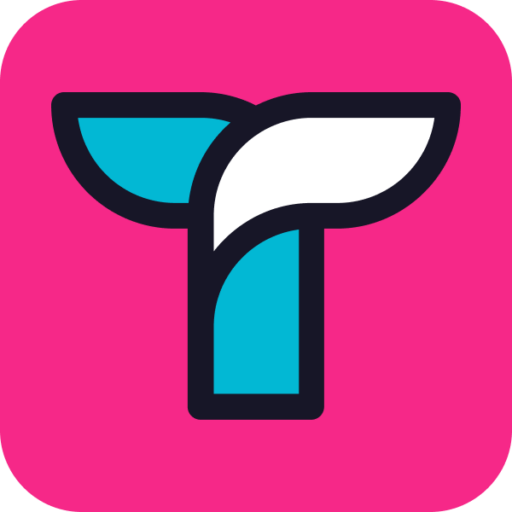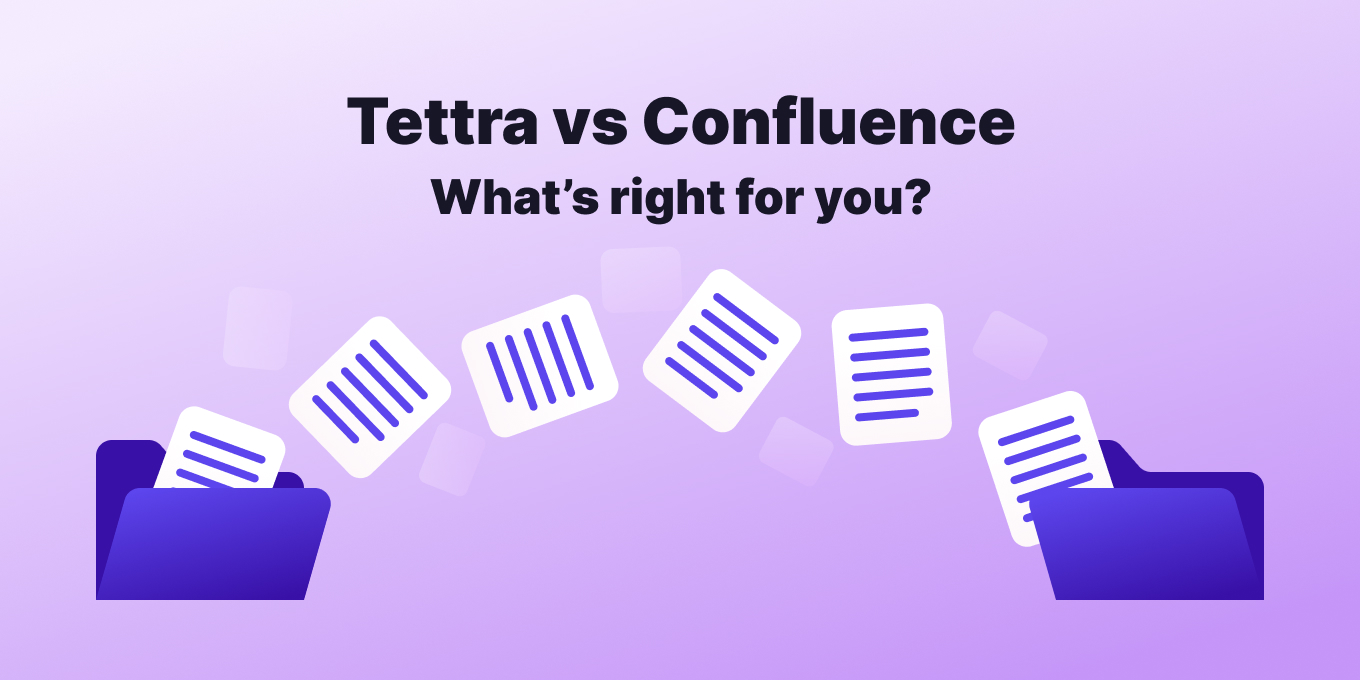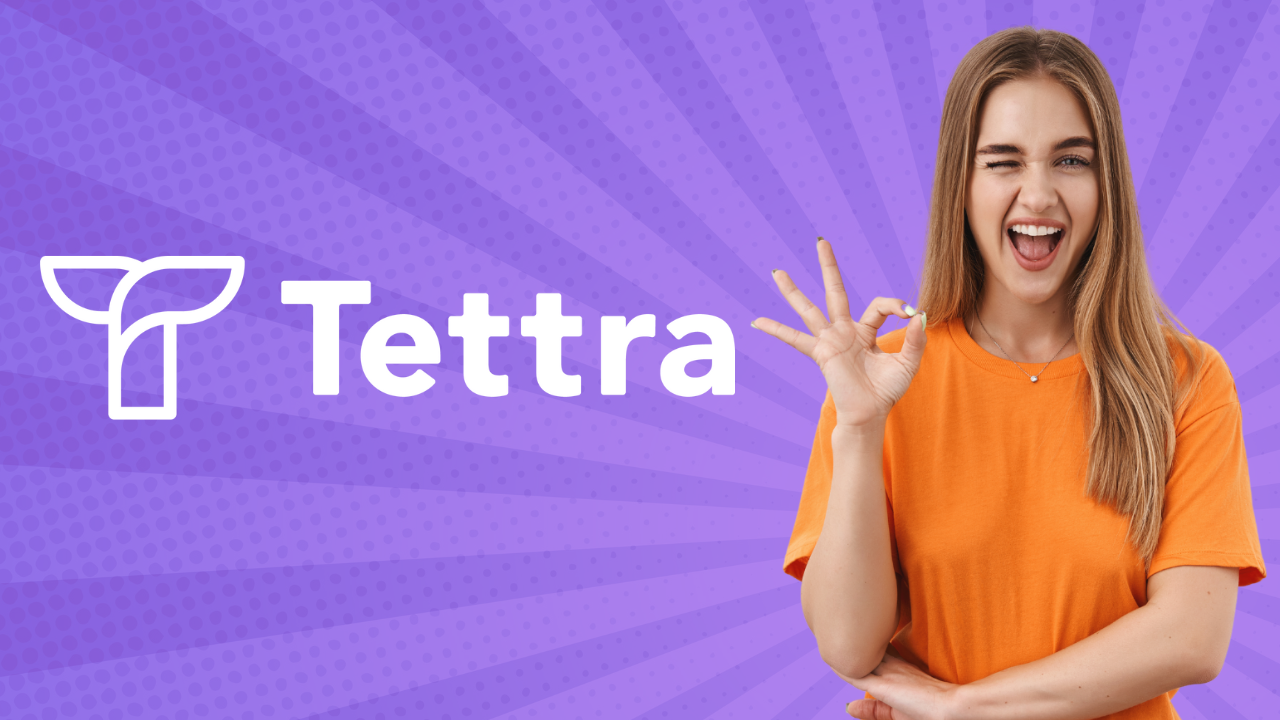TL;DR: Tettra is a simple, AI-powered internal knowledge base built for storing your documentation, Q&A and more. It’s *so* much easier to use than Confluence.
Tettra is especially great for growing teams that rely on Slack.
Tettra is rated higher than Confluence in these G2 categories:
| Confluence | Tettra | ||
| Ease of Use | 7.9 | ✅ 9.1 | |
| Ease of Setup | 7.9 | ✅ 9.7 | |
| Ease of Admin | 7.9 | ✅ 9.1 | |
| Quality of Support | 8.0 | ✅ 9.3 | |
| Has the product been a good partner in doing business? | 8.4 | ✅ 9.5 |
What can Tettra do?
Tettra is an AI-powered internal knowledge base that helps you curate important company information into a knowledge base, use it to answer repetitive questions in Slack and keep it up-to-date, organized, and complete with automation.
As cloud-based software, it has a simple, user-friendly UI and integrates with Slack, Google Drive, and more.
Tettra also has a powerful context-driven search feature that lets you find any information in seconds.
Tettra offers a full suite of tools for sharing knowledge. With Tettra, you’ll get:
- Q&A workflow to capture questions
- AI-powered knowledge base software to find answers fast
- Knowledge management features to keep content up to date.
- Integrations with Slack, Google Docs, Github and Zapier to help your team answer and capture knowledge quickly
It includes an intuitive UI and Slack integration, allowing users to utilize the knowledge base without leaving the popular messaging app. It also supports Microsoft Teams integration, so the knowledge base can be accessed directly from the Teams interface.
A standout feature is Tettra’s ability to designate “knowledge experts”, who can verify content and serve as the resident expert for certain topics.
Based on a G2 comparison, Tettra boasts a 4.6 / 5 star rating compared with Confluence’s 4.1 stars.
Pros of Tettra:
- AI-assisted answers right inside of Slack (talk with your docs)
- Intuitive interface
- Native Slack integration
- Less learning curve
- Unique knowledge management features
Cons:
- Lacks support for forums / discussion boards
- Limited document formatting
Pricing:
- Free to start
- Basic: $4 per user/month
- Scaling: $8 per user/month
- Professional: $12 per user/month
What can Confluence do?
Atlassian Confluence is a powerful suite of tools that can help your team manage and collaborate on documents. Confluence is a wiki software platform designed for knowledge management. It is the oldest wiki solution, having launched in 2004 but still remaining strong today.
Its popularity lies in its flexibility. The software includes an internal wiki, collaboration tools, and even a project management app. Confluence uses “spaces”, which are essentially workspaces for teams.
Each space can house its own knowledge base, documents, project trackers, and more.
Once your team has thousands of documents across teams, not everyone is an engineer or has technical chops. Confluence can be a confusing, clunky option when it comes to getting everyone on board and using the tool.

Get more info about Confluence
- Review other top Confluence alternatives
- Compare Confluence vs. Google Docs
- Compare Confluence vs. Guru
- Compare Confluence vs. Sharepoint
- Compare Confluence vs JIRA
Confluence’s word processor is severely limited. Complaints from users include poor page and column layouts, lack of styling options, bad implementation of numbered lists.
For more on the capabilities of Confluence, see their full feature list.
Pros
- Integrates with other Atlassian products
- Provides a comprehensive set of features for knowledge management
- Real time editing and commenting
- Granular permission controls
- Provide direct feedback on files
Cons
- Tiered pricing that can get very expensive as you add more users
- Limited Search Capabilities
- Clunky interface
- Limited amount of integrations
Price:
- Free for up to 10 users with 2GB storage
- $5.75 per user/month for Standard tier with 250 GB storage
- $11.00 per user/month for Premium tier with unlimited storage
- Call for pricing for Enterprise tier advance analytics and per user licensing
Confluence Problems
Confluence Problem 1: Unnecessary features
One of Confluence’s greatest strengths may also be its biggest drawback: too many features. Not all companies require the tools included in the suite, making it an expensive waste of resources, particularly for smaller to medium enterprises.
Confluence Problem 2: Steep learning curve
While Confluence’s UI may be familiar to IT professionals and users of Atlassian’s other products like JIRA, new users or non-technical people may find the interface and navigation a challenge.
Confluence Problem 3: No real-time view
When more than one person works on the same document or ticket, progress may be lost unless one user refreshes the page before contributing their own content. This lack of a real-time tracker or auto refresh function have resulted in loss of edits or work progress.
Confluence Problem 4: Lack of formatting features
Confluence’s word processor is severely limited. Complaints from users include poor page and column layouts, lack of styling options, bad implementation of numbered lists. You’ll need additional apps to make it really hum for your team.
Confluence Problem 5: Cost
In 2021, Atlassian dropped support for customized solutions, forcing companies to purchase their all-in-one cloud solution. Confluence has four price tiers: free, standard, premium, and enterprise.
Tettra vs Confluence: What’s right for you?
Here are some of the key differences between Tettra and Confluence:
- Tettra is AI-powered: Tettra uses AI to automatically categorize and tag content, making it easier for team members to find the information they need. Confluence does not have this capability.
- Tettra is integrated with Slack and MS Teams: Tettra integrates seamlessly with Slack and MS Teams, making it easy for team members to ask questions and find answers in real time. Confluence does not have this integration.
- Tettra is designed for knowledge management: Tettra is designed specifically for knowledge management, while Confluence is a more general-purpose wiki software.
| Tettra | Confluence Standard | |
| AI Features | Yes. Ask Q’s with Kai and get an answer from your knowledge base. | No, only offered on premium. |
| Search | Search the body of all content types, including documents. | You can search the body of pages, blogs and some attachment types, though there are many community forum posts indicating this doesn’t work as expected. |
| Knowledge Management Features | Yes. Get a question-and-answer flow, content verification, stale page updates, and more. | No, not without 3rd party add-ons. These likely carry a cost and are supported by those developers. |
| Category Management | Yes. You can have infinite nesting, custom ordering, external links, etc. | No. See more in their forum. |
| Slack Integration | Answer questions within Slack using Tettra content. Search, create and request content from within Slack. Use Kai, the Tettra AI assistant to ask questions and receive answers. | Interact with content within Slack. Send notifications to channels and users. |
| Analytics | Receive User, Page and Question Analytics via email and CSVs with no limit on history. | No user analytics and only basic page view analytics. See more in their forum. |
When choosing an internal knowledge base, don’t just look at the top brands. It pays to do your homework, determine what your needs are, and which vendor best fits your requirements.
- Do you need an internal knowledge base, a customer self-help portal, or all-around knowledge management?
- How large is your team?
- How much of the budget can you devote to knowledge management?
- Which product possesses the functions and integrations that are critical for your business?






